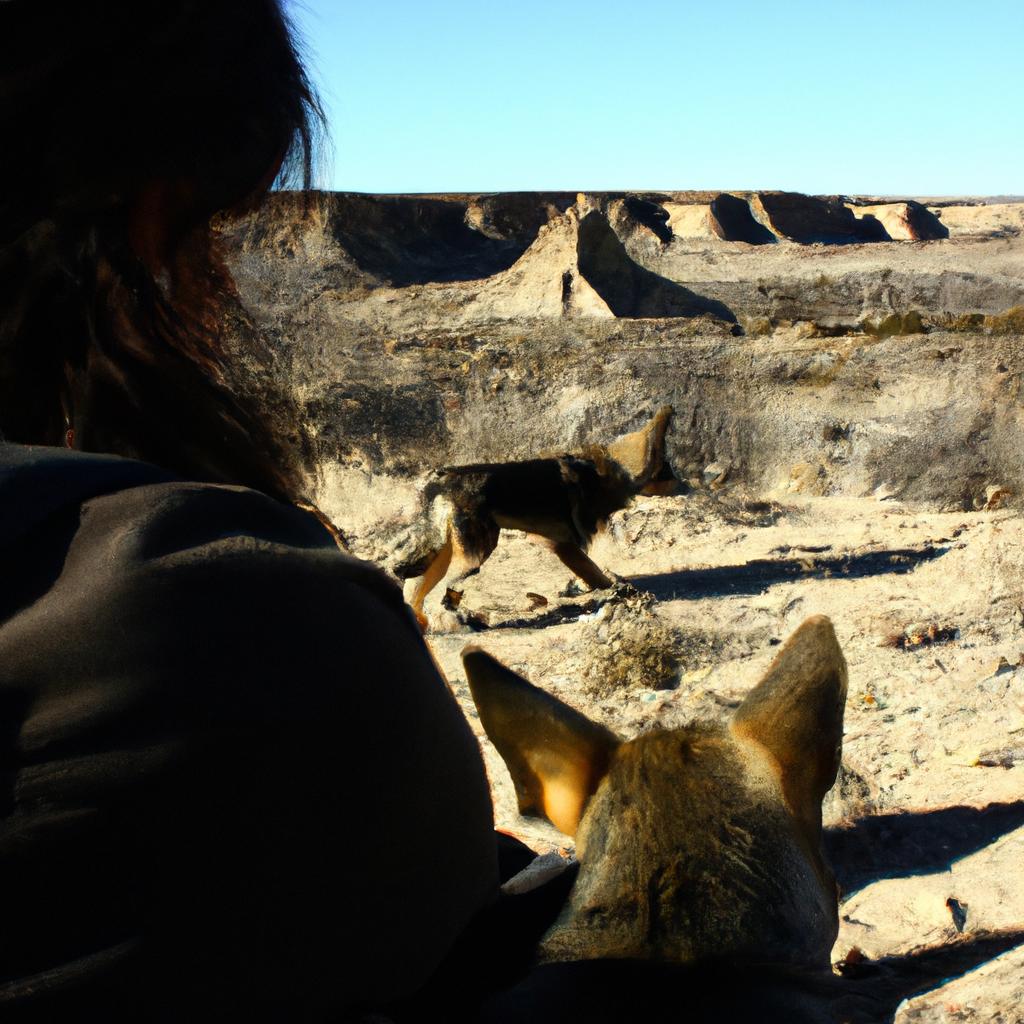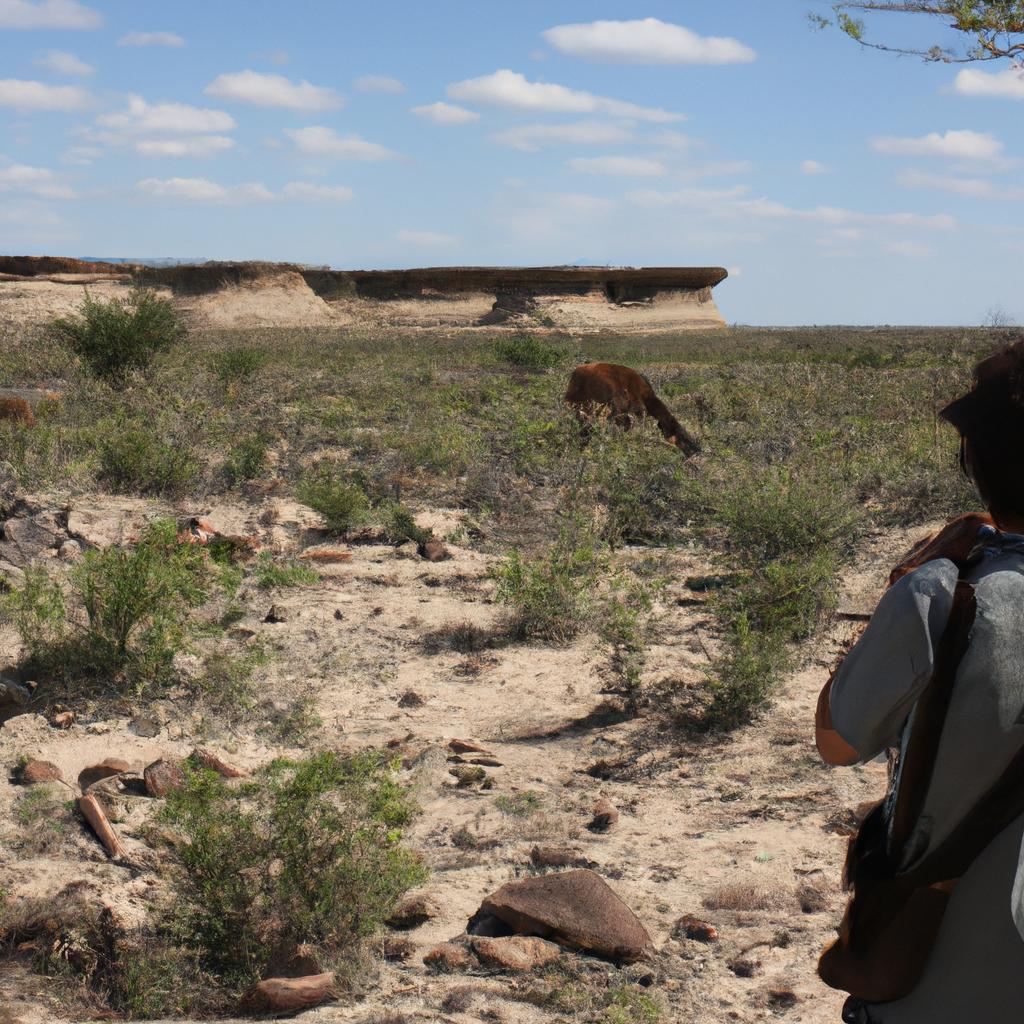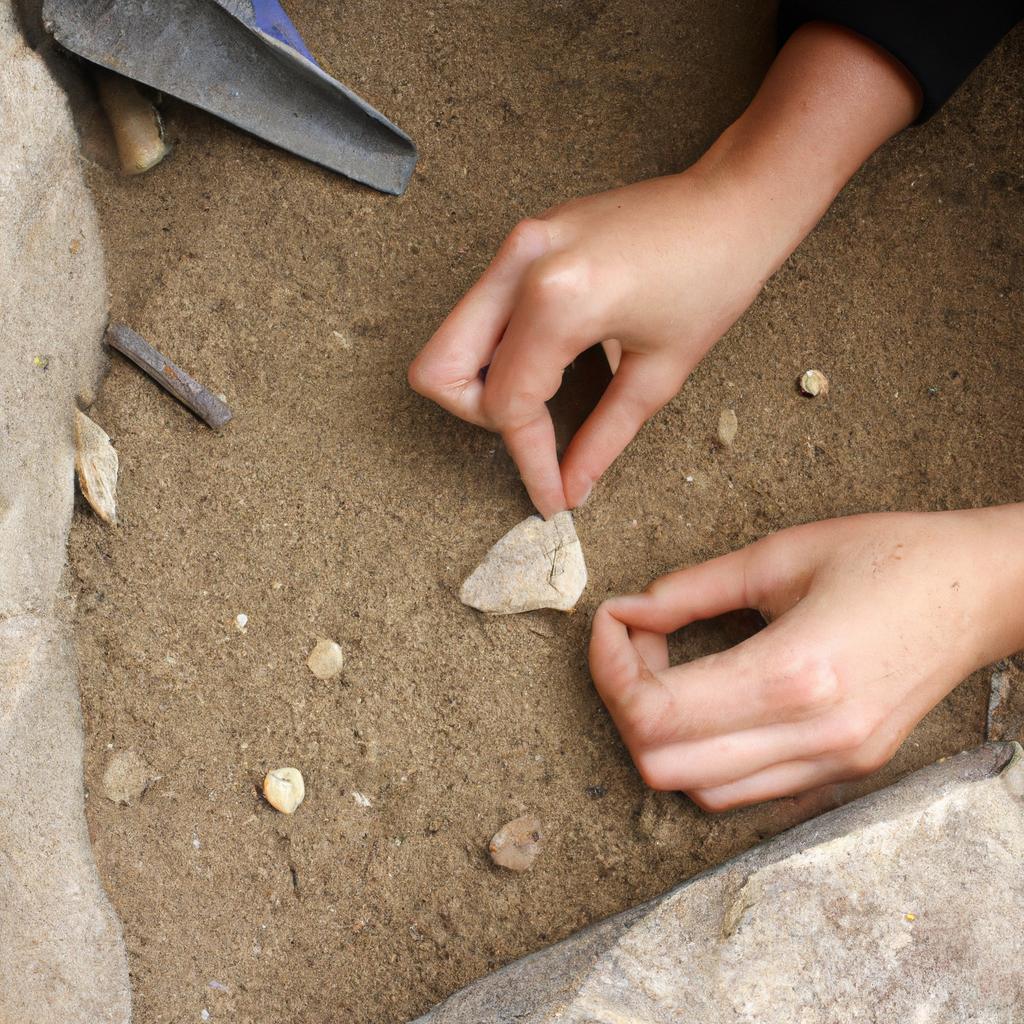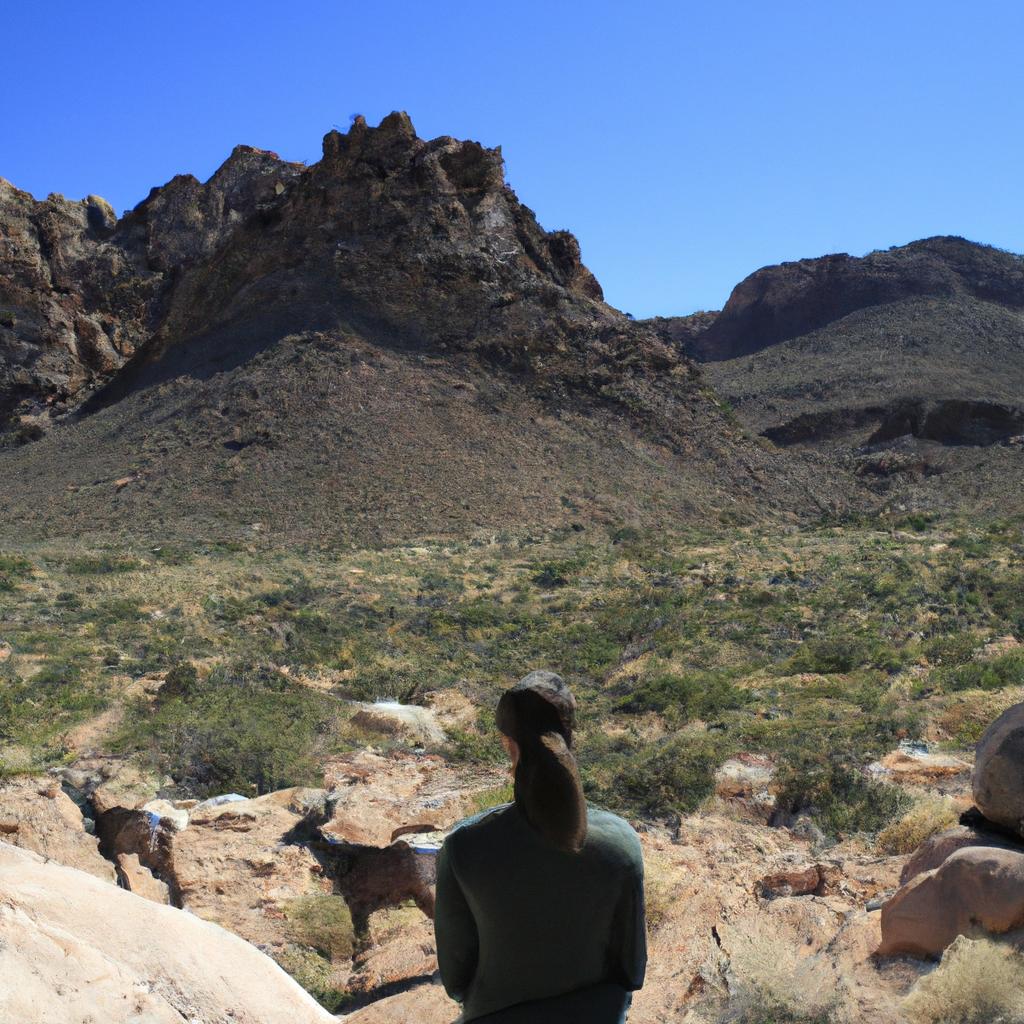Chaco Canyon, nestled in the heart of New Mexico, holds a captivating allure for both history enthusiasts and photography aficionados alike. The ancient ruins scattered throughout this archaeological site provide an intriguing subject matter for capturing stunning photographs. However, achieving visually compelling images requires more than just pointing and shooting; it demands a thorough understanding of key technical aspects such as depth of field. With its ability to manipulate focus within a photograph, depth of field plays a crucial role in enhancing the storytelling potential of travel photography.
Consider the following scenario: imagine standing before the imposing structure known as Pueblo Bonito at Chaco Canyon. Its intricate stonework stretches high into the sky, bearing witness to centuries-long human endeavors. As you raise your camera to capture this architectural marvel, adjusting your settings to emphasize depth of field becomes imperative. By intentionally setting a shallow depth of field, with only certain elements in sharp focus while others gently fade into softness, you can create a sense of intimacy that draws viewers into the scene. Alternatively, opting for a deep depth of field would ensure every detail is captured with clarity – from the smallest etching on the walls to the vast expanse beyond. Such deliberate choices serve not only to document but also to convey emotions and narratives within each photograph, allowing viewers to experience the grandeur and mystique of Chaco Canyon.
In the case of Pueblo Bonito, a shallow depth of field can be employed to isolate specific elements of the structure, such as its ornate doorways or weathered carvings. By blurring out the background and surrounding structures, the focus becomes solely on these intricate details, emphasizing their significance within the larger context of the ruins. This technique adds a touch of artistry to the photograph while also conveying a sense of mystery and intrigue.
On the other hand, utilizing a deep depth of field would ensure that every aspect of Pueblo Bonito is captured in sharp focus. This approach allows for a comprehensive documentation of the architectural masterpiece, showcasing its sheer scale and complexity. The viewer is immersed in the scene, able to appreciate not only the individual components but also how they come together to form this remarkable structure.
Ultimately, whether choosing a shallow or deep depth of field, it is important to consider your desired outcome when capturing photographs at Chaco Canyon. Experimenting with different settings will enable you to tell captivating stories through your images, preserving both the history and aesthetics of this extraordinary archaeological site.
Understanding Depth of Field
To grasp the concept of depth of field in photography, imagine yourself standing on a picturesque cliff overlooking a vast landscape. As you peer through your camera lens, focusing on a single subject—a majestic mountain range—everything else seems to fade into soft blurs and bokeh. This manipulation of focus is known as depth of field, an essential technique that photographers employ to create captivating images.
Depth of field refers to the area within an image that appears sharp and in focus. It can be adjusted by altering three key factors: aperture size, distance between the camera and subject, and focal length. By understanding how these elements interact, photographers can skillfully control the level of background blur or foreground sharpness they desire.
One way to comprehend the influence of depth of field is by considering a case study scenario. Imagine capturing a breathtaking sunset over Chaco Canyon—the ancient Pueblo civilization site nestled in New Mexico’s arid desert landscape. With a small aperture setting (e.g., f/22), you aim your lens at one particular adobe structure while keeping the expansive canyon views visible in the frame. The result? A sweeping vista with both foreground and background elements rendered sharply due to the large depth of field achieved.
To further illustrate its impact, let us examine four emotional responses evoked by different depths of field:
- Intimate Focus: When employing shallow depth of field (e.g., using a wide aperture like f/2.8) during portrait photography sessions, subjects become isolated from their surroundings. This technique draws attention exclusively towards people’s expressions, emphasizing emotions and creating intimacy.
- Ethereal Atmosphere: Utilizing medium depth of field settings (such as f/8) enhances landscape photographs by rendering details across various distances sharply while maintaining some degree of background blur. This approach imparts a dreamlike quality to scenes, evoking tranquility or nostalgia.
- Documentary Clarity: In photojournalism or documentary photography, a large depth of field (e.g., using a small aperture like f/16) ensures that all elements within the frame are in sharp focus. This technique allows viewers to observe intricate details and understand the context with utmost clarity.
- Artistic Isolation: By manipulating depth of field creatively, photographers can isolate specific objects from their surroundings. A shallow depth of field enables them to emphasize individual elements while blurring irrelevant distractions, resulting in visually striking images.
In conclusion, understanding how depth of field works empowers photographers to convey different emotions and create captivating visual narratives. In the subsequent section, we will explore Chaco Canyon—an exquisite location that offers numerous opportunities for experimenting with this technique—unveiling its beauty through various depths of field techniques.
Exploring Chaco Canyon
Now let us delve into the mesmerizing realm of Chaco Canyon, uncovering the unique photographic possibilities it presents when employing diverse depths of field.
Exploring Chaco Canyon
Depth of Field in Travel Chaco Canyon: A Photography Insight
Understanding Depth of Field
In the previous section, we delved into the concept of depth of field and its significance in photography. Now, let us explore how this principle can be applied when capturing images in a unique travel destination like Chaco Canyon. To illustrate this application, imagine standing at the edge of Pueblo Bonito, one of the largest ancestral Puebloan dwellings in New Mexico. As you aim your camera towards the intricate masonry work and ancient ruins within the canyon, understanding depth of field becomes crucial to create compelling photographs.
Exploring Chaco Canyon
To effectively convey the grandeur and historical context of Chaco Canyon through photography, consider implementing these techniques:
- Selective Focus: By using a wide aperture setting (e.g., f/2.8), you can isolate specific elements within the frame while blurring out distracting backgrounds. This technique allows you to draw attention to intricate petroglyphs or delicate pottery shards amidst the vastness of the landscape.
- Hyperfocal Distance: When photographing expansive views encompassing both near and distant subjects, utilizing hyperfocal distance ensures sharp focus throughout the scene. Set your lens to a small aperture (e.g., f/16) and adjust focusing accordingly to capture both detailed rock formations up close and sweeping vistas stretching far into the horizon.
- Bokeh Effects: Experiment with different lenses that offer beautiful bokeh effects – soft, out-of-focus areas created by light sources in the background – to add an ethereal quality to your images. Capture sunlight filtering through tree branches or evoking warm candlelit scenes during dusk for enhanced visual impact.
- Leading Lines: Utilize natural lines within Chaco Canyon’s architecture or surrounding landscapes as compositional tools to guide viewers’ eyes through your photographs. These leading lines not only provide a sense of depth but also create a visual journey for the audience, enhancing their overall experience.
By employing these techniques and understanding the principles of depth of field, you can capture the essence of Chaco Canyon in a way that transports viewers to this ancient landscape. In the subsequent section about “Capturing the Essence,” we will delve deeper into other aspects of photography that contribute to creating compelling travel images – all while maintaining respect for the historical significance and cultural heritage of this remarkable site.
Capturing the Essence
Depth of Field in Travel Chaco Canyon: A Photography Insight
Exploring Chaco Canyon revealed stunning landscapes and awe-inspiring archaeological sites. As photographers, capturing the essence of such a unique place requires understanding the concept of depth of field. By skillfully manipulating this aspect, one can convey different moods and highlight specific elements within their photographs.
Imagine standing at Pueblo Bonito, one of the largest ancestral puebloan structures in Chaco Canyon. With its intricate architecture stretching into the horizon, you frame your shot to capture both the grandeur of the structure and the surrounding landscape. To achieve this desired effect, utilizing a shallow depth of field becomes essential. By using a wide aperture setting (e.g., f/2.8), only the subject in focus remains sharp while everything else softly blends into an ethereal background. This technique helps emphasize particular architectural details without distracting visual clutter.
To fully comprehend how depth of field influences photographic outcomes, it is crucial to consider various factors:
- Aperture Size: Adjusting the aperture size directly impacts depth of field. Wider apertures create shallower depths of field by allowing more light to enter through a larger opening.
- Focal Length: Longer focal lengths tend to compress images and reduce perceived depth, making them ideal for isolating subjects against blurred backgrounds.
- Distance from Subject: The distance between photographer and subject greatly affects depth perception. Capturing close-up shots will naturally result in less apparent depth compared to distant views.
- Sensor Size: Different camera sensor sizes affect how lens settings interact with depth of field calculations. Smaller sensors may yield deeper depths due to inherent crop factor considerations.
In order to showcase these concepts visually, let’s explore a hypothetical scenario involving photographing petroglyphs found at Una Vida site in Chaco Canyon:
| Depth Setting | Camera Angle | Emotional Response |
|---|---|---|
| Shallow | Low | Intimacy and intrigue |
| Moderate | Eye Level | Connection with history |
| Deep | High | Vastness and grandeur |
By experimenting with various depth settings, camera angles, and associated emotional responses in our hypothetical scenario above, we can see how the manipulation of depth of field contributes to telling a visual story.
Understanding depth of field is just one step towards mastering aperture settings. In the subsequent section, we will delve deeper into this aspect, providing practical tips for achieving optimal results while photographing Chaco Canyon’s mesmerizing landscapes and archaeological wonders.
Mastering Aperture Settings
Depth of Field in Travel Chaco Canyon: A Photography Insight
Capturing the Essence
As we continue our exploration into capturing the essence of Chaco Canyon through photography, it is essential to understand the concept of depth of field. Depth of field refers to the range of distance within an image that appears acceptably sharp. By manipulating aperture settings, photographers can control how much of their subject matter is in focus and draw attention to specific elements within a scene.
Consider this hypothetical scenario: You find yourself standing at Pueblo Bonito, one of the most iconic structures in Chaco Canyon. The sun sets behind the towering walls as shadows dance across its ancient facade. To capture the beauty and grandeur of this moment effectively, understanding depth of field becomes crucial. With a shallow depth of field, you could isolate certain intricate carvings on the structure while blurring out distracting elements in the background.
To achieve desired results with depth of field, several factors come into play:
- Aperture size: A wider aperture (smaller f-number) results in a shallower depth of field, allowing for selective focusing on specific subjects or details.
- Distance from subject: Closer proximity to your subject decreases depth of field, emphasizing objects near to your lens while blurring those further away.
- Focal length: Longer focal lengths tend to have more prominent background blur compared to shorter focal lengths.
- Sensor size: Larger sensors generally produce images with shallower depths of field than smaller ones when using similar aperture settings.
To provide a visual representation and evoke an emotional response among viewers, consider this table showcasing different aperture sizes alongside corresponding examples:
| Aperture Size | Effect on Depth |
|---|---|
| f/1.8 | Very shallow |
| f/5.6 | Moderate |
| f/16 | Deep |
By skillfully utilizing these techniques, photographers can create images that not only capture the essence of Chaco Canyon but also engage viewers by drawing attention to specific elements within a scene. In our next section, we will delve into practical tips for achieving depth in travel photography and explore further avenues for enhancing your skills.
Tips for Achieving Depth in Travel Photography
Without explicitly labeling it as a “step,” let us now transition into exploring tips that will help you achieve greater depth in your travel photography.
Tips for Achieving Depth in Travel Photography
Depth of Field in Travel Chaco Canyon: A Photography Insight
In our exploration of mastering aperture settings, we have gained a deeper understanding of how manipulating the aperture can influence depth of field. Now, let us delve into some practical tips for achieving depth in travel photography.
Imagine capturing a breathtaking landscape at Chaco Canyon, where ancient ruins stand against the backdrop of vast desert expanses. To bring out the layers and textures of this historical site, it is crucial to master depth of field techniques. By controlling the aperture setting, you can enhance or minimize the area that appears sharp in your photographs.
To help you achieve stunning depth in your travel photography, here are some key strategies:
-
Selecting an appropriate aperture: Adjusting the lens aperture plays a vital role in creating depth. A wide aperture (small f-number) such as f/2.8 allows for a shallow depth of field, isolating subjects from their surroundings and emphasizing their details. On the other hand, a narrow aperture (large f-number) like f/16 increases the overall sharpness throughout the frame.
-
Utilizing focus stacking: In situations where both foreground and background elements require clarity, consider using focus stacking techniques. This involves taking multiple shots with different focal points and blending them together during post-processing to ensure maximum sharpness across all desired areas.
-
Composing with intention: Keep in mind that composition also contributes to achieving depth in your images. Incorporate leading lines or overlapping elements within your frame to create visual layers that guide the viewer’s eye through different depths of the scene.
Now let us explore these concepts further by considering an example scenario involving different apertures and their impact on depth of field:
| Aperture | Depth of Field Effect |
|---|---|
| f/2 | Shallow DOF; subject stands out sharply |
| f/8 | Moderate DOF; some background details retained |
| f/16 | Deep DOF; most elements in focus |
By understanding the effects of different aperture settings and incorporating compositional techniques, you can unlock your creativity and capture stunning images at Chaco Canyon.
Unlocking Creativity Through Composition
Depth of Field in Travel Chaco Canyon: A Photography Insight
In the previous section, we discussed various tips for achieving depth in travel photography. Now, let us delve into a specific aspect that can greatly enhance the visual appeal and storytelling potential of your photographs – depth of field. By understanding and utilizing depth of field effectively, you can bring focus to important elements while creating a sense of dimensionality and immersion within your images.
To illustrate the impact of depth of field on travel photography, consider this hypothetical scenario: Imagine capturing an image at Chaco Canyon—an archaeological site renowned for its ancient Puebloan ruins. You position yourself at the base of one of these magnificent structures, with the vast desert landscape stretching out behind it. Through careful manipulation of depth of field, you have the ability to emphasize either the intricate details of the ruin or showcase the expansive beauty of the surrounding environment.
Here are some key considerations when working with depth of field:
-
Aperture Setting: The aperture setting determines how much light enters your camera’s lens and influences the depth of field in your photograph. A wider aperture (smaller f-number) creates a shallow depth of field by focusing sharply on a specific subject while blurring out everything else. Conversely, a narrower aperture (larger f-number) increases the depth of field by keeping more elements within focus.
-
Focal Length: The focal length also affects depth perception in your images. Wide-angle lenses tend to provide greater overall sharpness throughout most distances, resulting in a larger apparent depth-of-field compared to telephoto lenses which often compress perspective and create shallower depths.
-
Distance from Subject: The distance between your camera and subject plays a crucial role in determining how pronounced or subtle the effect of depth will be within your composition. Getting closer to your main subject may result in a shallower depth-of-field while increasing distance tends to increase perceived depth.
-
Composition Choices: Consider how depth of field can enhance the composition and storytelling of your photograph. By intentionally blurring out elements in the foreground or background, you can guide the viewer’s attention to specific areas within the frame, creating a sense of depth and hierarchy.
To further illustrate these concepts visually, let us examine the following table:
| Aperture Setting | Depth of Field |
|---|---|
| Wide (f/1.8) | Shallow |
| Moderate (f/5.6) | Medium |
| Narrow (f/16) | Deep |
By consciously manipulating depth of field through aperture selection, focal length choice, subject distance control, and thoughtful composition decisions, you have an opportunity to elevate your travel photography by adding visual interest and immersive storytelling qualities.
In summary, understanding and utilizing depth of field effectively allows you to create captivating travel photographs that not only capture the beauty of a destination but also evoke emotions and engage viewers on a deeper level. With careful consideration of aperture settings, lens focal lengths, subject distances, and compositional choices, you can masterfully manipulate depth of field to bring focus to important details while conveying a sense of place and atmosphere.










